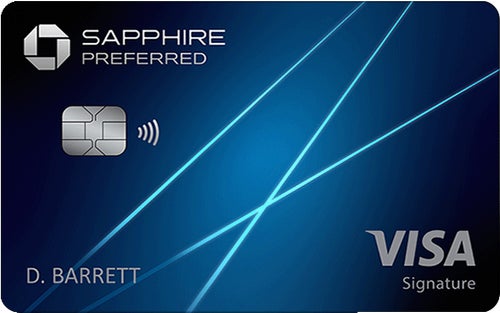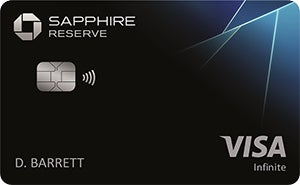At first glance, the Chase Sapphire Preferred® Card and Chase Sapphire Reserve® look similar. Their travel and dining rewards structures, welcome offers and their names all share the same DNA. But on second glance, it’s clear there are some key distinctions between these two travel credit cards.
The annual fee is perhaps the biggest difference, with the Preferred’s $95 annual fee provoking way less sticker shock than the Reserve’s $550. The rewards structure has a key difference, too, in that the Ultimate Rewards points you earn while spending carry a very different value between the two cards, given their respective values when redeeming points for travel through Chase Travel℠. The more expensive Reserve comes with significantly better travel perks and credits, including up to a $300 annual travel statement credit and access to a global chain of airport lounges.
In most situations, the Reserve offers better overall value. The large upfront cost is partially offset by the annual travel credit and greater rewards, leaving the majority of cardholders with a better return over the course of a year. But if you don’t like the idea of paying that much for a credit card, you’re not sure if you spend enough to make up for the difference in cost or you plan on transferring most of your Ultimate Rewards points to a travel partner, the Preferred could be the better option.
Comparing annual fees
Winner: Chase Sapphire Preferred
Even though you can think of the Reserve’s $300 annual travel credit as a reduction in the annual fee, what we’re really evaluating here is the upfront cost of owning the credit card. Regardless of what may come your way down the road, the reality is that $550 is a significant investment.
When looking solely at the annual fee, the Chase Sapphire Preferred is clearly the more affordable option at $95. It provides a much easier entry point into Chase’s travel rewards.
Welcome bonuses
Winner: Chase Sapphire Reserve
- Chase Sapphire Preferred: 60,000 bonus points for spending $4,000 in the first three months from account opening.
- Chase Sapphire Reserve: 60,000 bonus points for spending $4,000 in the first three months from account opening.
Although these welcome bonuses look identical, you can net a little more value out of the Reserve’s welcome bonus. Here’s why.
The Reserve’s welcome bonus can be redeemed for $600 as a statement credit or $900 for travel through Chase Travel (a 50% redemption bonus). Meanwhile, the Preferred can be redeemed for $600 as a statement credit or $750 when redeemed for travel through Chase Travel -- slightly less than the Reserve’s travel rate.
You could get more from both cards’ bonuses by utilizing point transfers to Chase’s travel partners. Given the right deal, you could see an even higher per-point value.
Rewards
Winner: Chase Sapphire Reserve
It’s closer than you’d expect given the difference in annual fees, but the Reserve still holds the advantage when it comes to rewards. The most important differences in our view is the Reserve’s 3x points on non-Chase travel spending (compared to the Preferred’s 2x), and 10x points on hotels and car rentals booked through Chase Travel (compared to the Preferred’s 5x).
These differences make the Reserve a better card for those who book travel outside of Chase Travel but also for those who book car rentals and hotels through Chase, which may seem a little counterintuitive. On the other hand, if you can’t take advantage of the hotel, car rental or non-Chase travel boosts, the Preferred could end up being a better option.
As always, be sure to look at your past six months or so of spending to see how the differences in rewards and reward categories could add up over time.
Annual credits
Winner: Chase Sapphire Reserve
This is one category where it’s not even close -- and there aren’t even any important caveats. The Reserve’s $300 annual travel credit and a Global Entry, TSA PreCheck, or Nexus statement credit (up to $100 every four years) are clearly superior to the Preferred’s $50 Annual Chase Travel Hotel Credit and modest annual bonus.
The Reserve’s $300 annual travel credit comes in the form of statement credits. Basically, any time you make a travel purchase, Chase will apply a statement credit to your bill, up until the first $300 has been spent. Note that you won’t earn rewards on those first $300.
Also note that the Preferred’s $50 annual hotel credit is only for hotels booked through Chase Travel, and the 10% anniversary points boost is actually equivalent to just over .1% of your annual spending when redeeming points for travel through Chase Travel -- much less than the marketing hopes to lead you to believe. So if you spend $25,000 in a year, you’ll earn an extra 2,500 Ultimate Rewards points, worth $31.25 when redeemed for travel through Chase Travel.
Read more: Best Credit Cards for TSA Precheck and Global Entry
Travel perks
Winner: Chase Sapphire Reserve
This is another category where the Reserve has a clear edge. The Reserve grants cardholders Priority Pass Select membership, a great benefit for those who use airport lounges. Reserve cardholders also get access to Chase’s Luxury Hotel and Resort Collection. This collection features over 1,000 luxury properties worldwide. When you book one of them through Chase with your Reserve card, you’ll get complimentary breakfast for two, Wi-Fi, early check-in and late check-out, a room upgrade if available and a special benefit worth up to $100, which is unique to each property.
One other thing to keep in mind is the Reserve’s enhanced travel and purchase coverage, which is more generous and flexible than the coverage you get with the Preferred.
As you’d expect given the difference in annual fees, the Chase Sapphire Reserve comes out on top in most categories.
But what’s important is understanding how much you value things like Priority Pass lounge access and hotel and rental car spending. It’s also important to know whether you plan on transferring your Ultimate Rewards points when you redeem them, or if you’re happy redeeming them through Chase Ultimate Rewards.
Generally speaking, if you spend more with the Reserve, you’ll get more in return. But don’t sleep on the Preferred -- it’s still a great card, and if you don’t want to put down $550 every year, it’s a great option to consider.
How Chase Sapphire Preferred® Card and Chase Sapphire Reserve® compare to other cards
FAQs
The Chase Travel platform uses a third-party booking tool that looks across a variety of airlines and hotels for the best prices, similar to Expedia or Priceline.
The tool itself is accessible and easy to use. However, you can’t always choose between the main cabin and basic economy. You also won’t earn miles or elite status points on the respective airline or hotel, since you’re not booking directly with them. When it comes to customer service, there can sometimes be issues resolving problems with third-party bookings.
That said, the rewards rate bump you get for redeeming your points for travel through Chase Travel is worth it for most people. But if you always prefer to book directly with an airline, you’ll still get 3x rewards points with the Reserve and 2x rewards points with the Preferred, and can transfer them to your favorite travel partner for redemption.
No, not at the same time. You can only hold one or the other. You also aren’t eligible for a Chase welcome offer until 48 months have passed since your last card application.
You can add authorized users for free with the Chase Sapphire Preferred. With the Chase Sapphire Reserve, it costs $75 annually for each authorized user.
You’ll earn points the same way for any purchase made by an authorized user.
More credit card comparisons
- Chase Sapphire Preferred vs. American Express® Gold Card
- Chase Sapphire Reserve vs. The Platinum Card® from American Express
- Best Credit Cards With No Annual Fee
*All information about the American Express Gold Card has been collected independently by CNET and has not been reviewed by the issuer.
The editorial content on this page is based solely on objective, independent assessments by our writers and is not influenced by advertising or partnerships. It has not been provided or commissioned by any third party. However, we may receive compensation when you click on links to products or services offered by our partners.



